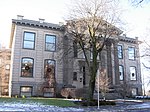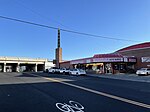Amman (Spokane, Washington)
Buildings and structures completed in 1904Buildings and structures in Spokane, WashingtonNational Register of Historic Places in Spokane, WashingtonResidential buildings on the National Register of Historic Places in Washington (state)Wikipedia page with obscure subdivision

Amman or Ammann, in the Browne's Addition neighborhood of Spokane, Washington is a building constructed in 1904. It was designed by architect Albert Held. The building was listed on the U.S. National Register of Historic Places in 1987. Although the National Register of Historic Places list the property under the name Amman the Spokane Register of Historic Places lists the building as Ammann.As of 2022, the building is known as The Dormitory and home to a mix of retail and office space surrounding the central common area on the first and second stories. Retail on the first floor, as of 2022 includes a coffee shop and roaster, and a bakery and cheese shop.
Excerpt from the Wikipedia article Amman (Spokane, Washington) (License: CC BY-SA 3.0, Authors, Images).Amman (Spokane, Washington)
West Riverside Avenue, Spokane
Geographical coordinates (GPS) Address Nearby Places Show on map
Geographical coordinates (GPS)
| Latitude | Longitude |
|---|---|
| N 47.656638888889 ° | E -117.43475 ° |
Address
West Riverside Avenue 1516
99201 Spokane
Washington, United States
Open on Google Maps











